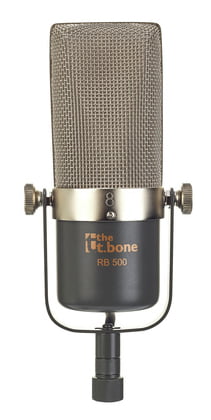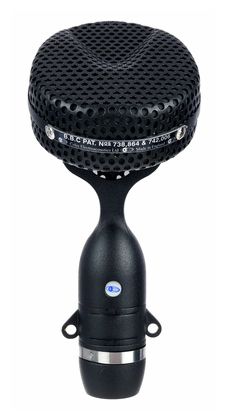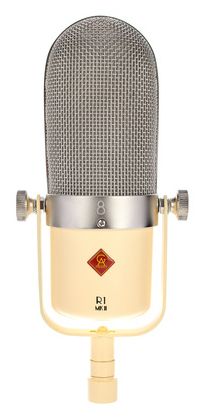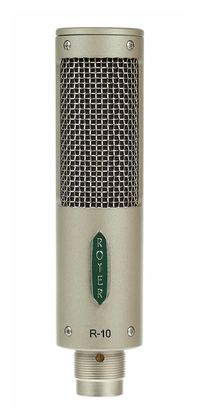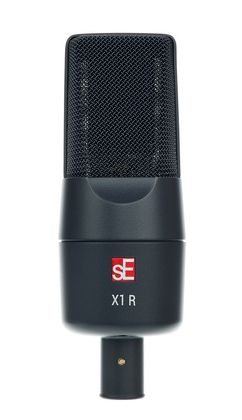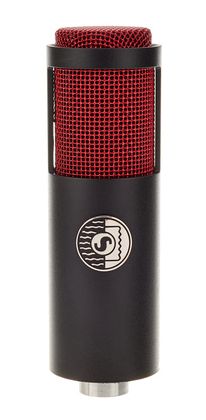Today’s installment will look at the top 6 ribbon microphones of 2024 for recording drums, vocals, and guitars. In a nutshell, here they are:
1. Beyerdynamic M160 (Best Rated on Thomann)
2. the t.bone RB 500 (Budget Choice)
3. Coles 4038 Studio Ribbon (Pro Choice)
Ribbon microphones follow a similar principle to Dynamic microphones in converting acoustic energy into electrical energy: through electromagnetism. A thin strip of metal (called a ribbon) within the microphone’s capsule is suspended between two opposing magnets.
The thickness of the ribbon is about half the diameter of human hair. Ribbon microphones can capture detailed sounds because this light, fragile strip reacts flexibly to vibrations.
When sound waves contact the ribbon, it vibrates, creating an electrical charge. At this point, electromagnetism, as mentioned above, kicks in. Once the charge is made, it passes through the signal wires attached to either end of the ribbon, which produces an electrical signal similar to the incoming sound wave.
The ribbon microphone closely resembles how the human ear receives and interprets sounds, which is why these microphones are so pleasing to hear.
Before we begin, here is a bit of a history lesson for you: Ribbon microphones made their first commercial appearance in the 1930s and were popular for broadcasting and recording up until the 1960s.
Once digital recording began, the Ribbon microphone was revived because its innately smooth and warm sound brought out the best in everything from brass instruments, drum overheads, stringed instruments, and vocals.
Top 6 Ribbon Mics 2024 (For Recording Vocals, Drums & Guitars)
1. Beyerdynamic M160 (Best Rated on Thomann)
One does not have to look far to find out that this unique ribbon mic was used by Eddie Kramer when recording vocals and guitars for Jimi Hendrix and by Andy Jones when recording the iconic drum sound in Led Zeppelin’s When The Levee Breaks.
The M160 is a front addressed, dual ribbon, hypercardioid microphone. Their small size and light frame make them easy to position and will put less strain on your mic stands – if you don’t own any heavy-duty stands.
Key Features:
- Dual Ribbon Design
As mentioned, a dual ribbon design is used for the transducer. These microphones have a wider frequency response because of the increased surface area of the ribbon their unique design offers. As an added note for those curious minds, the two ribbons are made of pure aluminum.
- Hypercardioid Pick Up Pattern
Many ribbon microphones utilize a bidirectional (figure-eight) polar pattern; going against the grain, the M160 uses a hypercardioid polar pattern. This polar pattern gives them a unique edge in that it offers a narrower range of pick-up (-25dB at the 110° point), which helps with isolating a sound source when recording by lowering the pick-up of any ambient sounds from the side.
- Frequency Range
The frequency range begins at 40 Hz and ends at an even 18 kHz, covering a large enough spectrum to capture the important bits of any sound being recording. This wide range adds to how diverse their applications are.
- Frequency Response
The frequency response is very close to being flat. A gradual (6dB) bass to sub-bass roll-off occurs from the 80 Hz mark and remains flat up until the 1.5kHz mark, where a slight boost occurs (less than +4 dB) before gradually rolling off to the 18 kHz mark.
The frequency response is stated to have a ± 2.5 dB tolerance. Extra note: Be aware of the bass response when close miking. Because of the hypercardioid pick-up pattern, the proximity effect can cause an increase in bass response up to 12dB.
- Front Addressed Mic
Adding to its uniqueness, the M160 is a front addressed ribbon microphone, which means they pick up sound from the tip of the microphone, unlike its cousin, the M130, that pick-ups from the sides. A black band surrounds the sphere, housing the two ribbons that indicate the microphone’s sides, making the front easy to identify.
Character & Sound:
The tone can be described as warm, silky, and rich. The bass response is thick and clear. The mid-range has enough presence to provide the body needed to stand on its own in a recording. The higher tonal area rolls off gradually enough to allow additional microphones – like an SM57 aimed at the center of a guitar amps cone – in a recording or sounds in a mix.
The M160 has an excellent response to transients and can reproduce sound waves with their natural tone intact (as long as your space is acoustically pleasant and treated).
Pros:
They handle high SPLs well, which shows why these microphones are recommended for drums and voluminous guitar stacks. And when it comes to loud, teeth-bearing guitars, they can take the harshest of sound tones and reproduce them with a smoother bite while still retaining their distorted edge.
Cons:
When used on quiet or distant sound sources, a relatively low sensitivity makes the M160 hair-raising; a preamp is recommended if you prefer not to turn the gain up too high.
With their vintage, iconic, and well-used sound, they may not be for everybody, so consider whether, as an engineer and based on your style, they are what you want to add to your collection.
Good For:
You can use them for drums, brass instruments, guitars (both acoustic and electric), guitar amplifiers (Whether clean-toned, highly distorted, or overdriven), other stringed instruments, vocals, and woodwind instruments.
And, as stated on Beyerdynamic’s product page, the M160’s inconspicuous design and matte black finish will reduce glare and overall shine, making them a good addition to the set of film or television productions.
2. the t.bone RB 500 (Budget Choice)
Thomann’s very own t.bon RB 500. A budget ribbon microphone that offers a tone with a lot of character.
The t.bone RB 500 is the cheapest ribbon microphone on this list. It is a bi-directional ribbon microphone with a very slow sensitivity, high SPL handling capabilities, and a built-in XLR cable.
Key Features:
- Built-In XLR Cable
A 3m (± 9.8 feet) long XLR cable is built into the microphone’s case. The casing itself is not internally spacious enough to replace the cable with an XLR input, so you will need to attach another XLR cable should you need to cover a longer distance to connect the mic.
- Sensitivity
Thomann’s t.bone has a very low sensitivity rating of -57dB/PA, making them less sensitive than an SM57, so if you are struggling to capture a fuller tone despite high gain, a natural way to increase gain is to move the microphone closer to the source.
In some cases, recording a source out of phase with a secondary microphone can cancel out the bass end enough that the proximity effect doesn’t color the image too much.
- Frequency Range
The RB 500 has a frequency range of 30 Hz to 18 kHz. There are some inconsistencies in documentation; the microphones product details page and manual state a 20 Hz – 20 kHz frequency range but a roll-off in frequency response does occur shortly after 10 kHz.
- Frequency Response
The frequency response is not flat. There are numerous peaks and dips throughout, but they are not severe enough to affect the tone. The bass end does have a shelf boost which explains the microphone’s thumpy tone.
Character & Sound:
The t.bone RB 500 has a punchy/thumpy tone while retaining the clear high mid-range. This microphone adds a lot of character to the sound being recorded, so if you are looking for a natural-sounding recording, this microphone is not for you.
Pros:
Has a very affordable price tag for a ribbon microphone. They do a good job of capturing the weighted thump of a guitar string, and when used as overheads, the punch of the toms is set up from behind the drum kit.
Cons:
The character added to a recording will not be for everyone. It won’t apply to every situation, song, or genre, so consider whether this is the kind of tone you want to add to the spice rack that is your microphone collection.
The XLR connector is built-in, which may raise some concerns since, should a conducting wire break, you will need to open the microphone to replace the cable – or send the mic in for repairs if you do not have the expertise to fix it.
Good For:
Great for drum overheads, guitars, and percussion if you’re looking for a distinctive punchy sound to add some weighted bass end to the low-mid range of your recordings.
To add to their use as an overhead mic, you should keep in mind the toms will be more prominent because of the character this microphone adds to the sound.
3. Coles 4038 Studio Ribbon (Pro Choice)
Coles is known for offering very well-made and great-sounding ribbon microphones. The 4038 was created for the BBC, for broadcasting, in the 1950s. The patents and production were transferred to Coles Electronics in the 1970s, and they have been in production ever since.
Coles Electronics’ 4038 is a bi-directional, side-addressed, ribbon microphone stating an “exceptionally flat” frequency response from 30 Hz to 15 kHz. This great microphone is used in many professional studios the world over.
Key Features:
- Bi-Directional Polar Pattern
The polar pattern is well balanced, with an even pick-up throughout. The well-balanced pick-up range allows easy blending of the ambient room sound and the direct sound source when recording, especially for brass instruments and overheads which may not be positioned as close to the microphone as a guitar amp or vocal.
- Output Impedance
The output impedance sits at 300 Ohms. When looking at impedance, you’ll want to aim for a load impedance five times the output impedance, so check your console or interface’s preamp specs to see if they have an output impedance over 1.5 kOhms. Otherwise, a preamp or inline preamp is recommended.
- Frequency Range
A frequency range of 30 Hz to 15 kHz is captured. The frequency range doesn’t extend as far into the high end as other microphones on this list, but because of its great tone, the lack of air naturally leaves room in the mix for more high-end tones or for the addition of another mic with a higher tonal pick-up.
- Frequency Response
The frequency response is smooth and slightly elevated, with a couple of dips throughout the spectrum. The first dip is between 400 Hz and 500 Hz. The second dip occurs after 10 kHz before rolling off to 15 kHz. The mic offers a smooth and natural tone despite the recorded frequency response.
Character & Sound:
Overall, you can expect a warm low end, balanced mid-range, and clear tone.These microphones do a great job of capturing the body of the sound in the room without coloration of said sound because of their ability to capture sounds and transients, alongside all ribbon microphones’ innate roll-off of high frequencies.
The sound source does seem closer than you may expect when recorded using the 4038, so keeping the mic at a distance of about 15 cm – 6″ – can help with that.
Pros:
The 4038 has a unique paddled, hoof-shaped design, making them easy to position when recording in a studio, especially for stereo miking techniques for overheads and piano. The blumlein technique for overheads shows very good results with them.
Cons:
Coles’ 4038 may prove difficult to fit into a highly produced, modern song with its crooner style and intimate tone. If you are looking for a vocal ribbon mic for anything other than a solo artist and their guitar, this is not the microphone for you unless that early jazz era sound is what you are searching for.
This microphone is one of the highest-priced entries on this list which may be too high for lower budget or home recording studios.
4. Golden Age Project R1 MK2
Golden Age Project strives to create gear inspired by a bygone era for the average consumer, and the R1 MK2 does just that with its vintage design, modern components, and attractive price tag.
The Golden Age Project R1 MK2 is a swivel-mounted, bi-directional, side-addressed ribbon microphone. Its low sensitivity and high SPL handling capabilities make them built for recording larger-than-life sounds but perform well with smaller stringed instruments if you have the gain to spare.
Key Features:
- Built-In Cable Clip
A mic cable clip is built into the base of the T-shaped swivel, making it easier to tuck the cable away and keep it tidy. However, this does mean you will need to unplug the microphone whenever it needs to be adjusted since the XLR will restrict the swivel’s movement should you need to arc the microphone to aim at a sound source.
- Sensitivity
Golden Age Project’s R1 MK2 has a very low sensitivity rating. It is stated to have a -52dBV/PA rating at 1kHz. The well-used Shure SM57 doesn’t sit far behind, with a -56.0 dBV/Pa rating. The low sensitivity means having them in a room with a drum kit or guitar stack will still require a good amount of gain before a solid tone is achieved.
- Maximum SPL
A maximum SPL of 160dB – at 1kHz – can be reached before distortion occurs, surpassing the human ear’s pain threshold of 130dB SPL. The maximum SPL rating doesn’t account for the surrounding frequencies, but it does show why they are recommended for those larger, more robust sounds like guitar stacks, brass instruments, and drum kits.
- Frequency Range
The R1 MK2 can capture a frequency range of 30 Hz to 18 kHz. Unfortunately, the frequency response of this range is not documented, so there is no evidence indicating its efficiency in capturing and reproducing a spectrum.
Character & Sound:
The tone can be described as well-rounded and clear. The low end can sound tubby, especially on large-bodied acoustics, so if you are working with a room that does not respond well to the low end when recording, placement is key; otherwise, using an EQ to adjust the tone is recommended.
If placed at a fair distance from the source, the tone sounds smoother – almost compressed. They perform well in capturing a complete and unbiased sound with a high-frequency roll-off, mid-range presence, and great transient response.
Pros:
The R1 MK2 has an affordable price compared to other ribbon microphones on the market, and in terms of performance, you get your money’s worth. They react well to EQ – EG: Boosting the high end to add some air to a vocal recording – without adding unwanted characteristics. Their uses open up widely because of this.
Cons:
To get the best tone, you will need a preamp impedance of at least 3kOhms. The required load impedance means that if your audio interface or mixer’s preamp does not meet the requirements, you may spend half of what the microphone costs, or more, to use them effectively.
If space concerns you, you can purchase an inline preamp. EG: You can look at the cloudlifter inline preamp. The proximity effect can significantly impact the tone, so be mindful of placement when direct miking instruments; otherwise, you are in for a tubby tone.
Good For:
Despite their recorded recommended uses, stringed instruments perform well with Golden Age Project’s R1 MK2. Especially ukuleles, mandolins, small body acoustics, and violins. They also do a great job of capturing cymbals, specifically the initial impact of the cymbal.
5. Royer Labs R-10
Royer is a brand known for making high-quality ribbon microphones, and the R-10 adds to that legacy – but with a lower price point than their other models.
The R-10 is a bi-directional, side-addressed ribbon microphone with a built-in transformer, internally shock-mounted ribbon, and multi-layered windscreen. In addition, they are the cheapest model in Royer’s Ribbon mic catalog.
Key Features:
- Patented Offset Ribbon
Royer Labs’ R-10’s ribbon is positioned closer to the logo’s side of the microphone. The offset ribbon allows them to handle higher SPL when direct miking an instrument with that side. A brighter tone is captured with the ribbon being distanced when miking from the opposing side (no logo). The Character & Sound section will provide more detail on this.
- Multi-Layered Wind Screen
The capsule has a built-in multi-layered wind screen which reduces plosives and gusts of air, as long as you do not intentionally blow into the mic. Additionally, the wind screen reduces the effects of the proximity effect, making bass build-up more manageable when close miking. However, this does not negate the proximity effect entirely.
- Internally Shock Mounted Ribbon Transducer
The ribbon is shock-mounted internally, which reduces the effects of shocks and vibrations and allows them to be used without a stand attachable shock mount. Which most certainly helps when setting up in tight spaces like around a drum kit.
- Frequency Range
The R-10’s frequency range covers a good 30 Hz to 15 kHz. The bass range extends well into the sub-bass region before sharply rolling off, which shows why the R-10 can capture a darker tone.
- Frequency Response
The frequency response for this microphone curves slightly throughout the spectrum. Two areas show a slightly broad boost, which can be heard in their tone, from roughly 50 Hz to 100 Hz and then again between the 1 kHz to 5 kHz range.
Two slight dips occur, the first in the low-mid range (from 200Hz to 1 kHz) and the second in the upper-mid to high-end (from 5 kHz to 15Khz).
Character & Sound:
Two tones are offered when recording. The logo side of the microphone has a tone that focuses more on the bass to mid-range. The opposing side offers a slightly brighter tone with less re-activeness to the proximity effect, which is recommended for lower SPL instruments.
You will need to flip the incoming signal’s phase when recording from this side. The two tones will give you great options when direct miking. EG: When recording two acoustic guitars, one guitar could be recorded using the front face to get a lower register tone and the second guitar using the brighter rear face.
Recording like this can help get a clear separation between the two guitars before mixing.
Pros:
The R-10 offers a maximum SPL of 160 dB at 1kHz, which shows why they are recommended for brass instruments, drums, and close miking in the studio and live environments.
To add to the SPL train, the logo side of the mic handles higher SPL levels better because of the offset Ribbon. Royer offers a 5-year warranty and the first re-ribbon for free within 12 months of purchase.
Cons:
Recording quieter instruments may require a preamp offering cleaner gain to provide the assistance needed to perform optimally – Royer does offer an inline dBooster with two switchable gain settings.
Good For:
Loud monstrous sounds are where this microphone performs best: Electric guitars, drums – even more so if you can buy a pair for stereo miking – and brass instruments. Using the R-10 as a room mic has also shown great results.
Despite the initial statement, if you are an engineer who enjoys vocals reminiscent of the crooning jazz era, they are recommended for that smooth and sultry sound.
6. sE Electronics X1 R
sE Electronics, a company well known for their diverse range of accessories and hand-made microphones, features a contender on this list called the X1 R – the second edition in their X1 series of microphones.
sE Electronics’ X1 R is a passive, bi-directional, side-addressed ribbon microphone featuring the company’s High-Frequency technology. Recordings present the tone synonymous with ribbon microphones with added clarity and sizzle because of the HF technology.
Key Features:
- Phantom Power Protected
The transducer has built-in protection against phantom power protecting the ribbon from damage. This means should your desk provide global phantom power; the ribbon will be safe when the mic is plugged in.
- sE Electronics High-Frequency Technology
As mentioned, sE Electronics’ X1 R uses High-Frequency technology originally introduced in the company’s Voodoo series VR1 and VR2 ribbon microphones. This technology gives them a clearer high-range tone most ribbon microphones inherently lack and highlights their recommendation for guitars, vocals, and overheads.
- Bi-Directional Polar Pattern
Sound waves are picked up on either side in a figure-eight pattern, attenuating sounds by 25dB from the sides – the 90° and 270° mark. Couple this with their great overall frequency response, and you have a recipe for good-sounding drum overheads.
If you can purchase a pair, they can be set up using the blumlein technique – placed on top of each other, 90° off-axis, and either in front of the drum kit or overhead – to capture a fat-sounding drum room.
- Frequency Range
This microphone can capture a frequency range of 20 Hz to 16 kHz. Like most ribbon microphones, the upper-frequency range does not extend too high into the spectrum. The previously mentioned HF technology does help in this regard.
Add in good placement, and you will have a well-rounded tone with minimal use of EQ – as long as the room has a good frequency response/is treated.
- Frequency Response
The frequency response is marginally flat with two boosted areas in the mid-range and hi-end of the spectrum. The low-frequency range rolls off from 40 Hz and is flat up to 500 Hz before being boosted slightly at 550 Hz.
From 600 Hz, the response is flat again up to the 3 kHz mark. A bell curve boost below 6 kHz affects the response from 3 kHz to 10 kHz before rolling off to the 20 kHz mark.
Character & Sound:
The X1 R has a well-rounded tone that captures instruments and vocals well. The low end is thick and warm. The mid-range has enough presence that the tone sounds full. And the high end is crisp enough that recordings have clarity without the harshness that condenser microphones normally present.
The room’s ambiance will shape the tone of the recording when using a bi-directional pick-up pattern, so be mindful of the inherent tone of the sound source and the room. Based on personal experience, if you find the depth captured by the rear face is too deep, placing an insulated panel a few feet behind the microphone can help adjust the depth captured.
Pros:
An affordable, high-quality microphone that captures a wide range of instruments, great for any recording engineer or artist starting their microphone collection or looking for their first ribbon microphone. The High-Frequency Technology adds clarity to an already great ribbon tone, potentially reducing the amount of elbow grease needed during the mixing phase.
Cons:
A shock mount does not come with the microphone, so one will need to purchase a mount separately should they need one. sE Electronics does offer an unobtrusive shock mount for their X1 series microphones.
Good For:
The X1 R is recommended for brass instruments, drum overheads, stringed instruments, and vocals. They are recommended for drum overheads because they do a great job recording natural in-the-room sounding overheads.
For stringed instruments, they are primarily used for guitars. And as for vocals, if you are looking for a natural, uncolored recording of vocals, this microphone is recommended.
Extra:
Shure KSM 313/NE Dual (Pro-Choice 2)
Shure is a company renowned for making great, durable microphones with versatile applications. The Shure KSM313, created by Crowley & Tripp from Soundwave Research Laboratories and later acquisitioned by Shure, adds to that legacy with its extensive range of uses, robust design, and exquisite tone.
The Shure KSM313 is a bi-directional, side-addressed, dual-voicing ribbon microphone. With its two-tone capabilities and Shure’s proprietary ribbon material, the KSM313 has a safe and diverse range of uses that may take some getting used to for a ribbon microphone.
Key Features:
- Dual-Voicing
Similar to Royer’s R-10 listed above, the front face and back face offer two distinct tones. The front face of the microphone offers the distinctive warm, smooth tone found in all ribbon microphones, making them great for taming bright sound sources and smoothly bringing out the bass body of an instrument.
The rear face of the microphone offers a brighter tone great for capturing the clarity much desired for vocal and voice-over recordings.
- Rosewellite® Ribbon
Shure’s series of ribbon microphones – the KSM313 and KSM353 – use the company’s proprietary Rosewellite® material for their ribbons.
This material can withstand much higher pressure levels, plosives, and phantom power application, making it a more durable alternative to the standard foil ribbons. Additionally, the ribbons can better hold their shape, increasing their transient response at higher pressure levels.
- Double-Shielded Transformer
The output transformer offers higher resilience against radio-frequency and magnetic interference while still giving you a strong output signal, which helps with delivering a clean, high-quality tone when recording.
- Frequency Range
The KSM313 has a frequency range of 30 Hz to 15 kHz. Each face of the microphone will react uniquely to this range of frequencies which is important to keep in mind if you are looking to use any stereo miking techniques.
- Frequency Response
The frequency response differs from the front face to the rear face. The front face’s lower mid-range has two minimally boosted areas: the first just below 200 Hz and the second between 300 Hz to 400 Hz.
The upper mid-range has a small boost just before the 2 kHz mark and another between 3 kHz to 6 kHz. After 6 kHz, the response rolls off to between 9 kHz and 10 kHz before plateauing to 15 kHz. The rear face has a similar frequency response, but the high end extends further, up to 10 kHz, before rolling off to 15 kHz.
Character & Sound:
The front face of the microphone offers the standard warm and smooth tone expected from ribbon microphones but with more of a focus on the low, mid-range, which explains their recommendation for guitars.
The rear face of the microphone offers a blend between the expected ribbon tone and a more pronounced high-end, making it ideal for capturing vocals.
Pros:
It is more durable than standard ribbon microphones, making them comfortably usable for direct kick drum recording and bass amp recording. The microphone’s small size makes them easy to maneuver and position when miking up a sound source and leaves room for any extra mics needed.
The KSM313’s tone offers a lot of versatility that doesn’t restrict itself to a niche area in terms of soundscape, making it applicable in most genres/songs.
Cons:
The high price puts this microphone in the high-end category of microphones which may not be accessible to everyone, but the quality and diverse range of uses make up for it. You will need a preamp with an output impedance of over 1 kOhm to use this microphone effectively since it has an impedance of 270 Ohms.
Good For:
They are good for capturing kick drums and guitars using the front face. The rear face is ideal for vocal recordings. A pair can be used as overheads if you have a pair because the dual-tone would not get a balanced sounding overhead with just one KSM313.
Verdict
There are many great microphones in this list that cater to many recording areas, some more expensive than others and some more niche. There is a microphone for everyone on this list. If you are looking for a microphone that offers more bang-for-your-buck and a clear tone, the sE Electronics X1 R is your microphone.
That is not to say that they are the best ribbon microphones available.
Coles’ 4038 and Shure’s KSM313 take the top two spots in quality, but they fall under the high-end microphone range, so if your budget stretches that far, they are the two top contenders for you. Of these two microphones, the KSM313 is recommended because the tone offered is more diverse and will lend itself to a wider range of recordings.
If you are looking for a very affordable ribbon microphone, the decision is between Golden Age Project’s R1 MK2 and Thomann’s t.bone RB 500. The R1 MK2 offers a more balanced tone that could have more practical uses when recording than the RB 500.
Related Readings:
Top 10 Mics For Recording Choirs (Best Rated)
Top 6 Cheap Dynamic Mics For Vocals
Top 12 Microphone Brands (Condenser, Dynamic & Ribbon)
Why Does My Microphone Pick Up A Loud Buzzing Sound?
The 12 Best Microphones For Field Recording
12 Best Cheap Condenser Microphones

A part-time sound engineering lecturer and musician based in Pretoria, South Africa. He has had a passion for all things music since he was big enough to sit on his cousin’s bed and strum away on an old guitar. All while his uncle, in a room below him, stood with a broom in hand and drummed along on the ceiling. When he isn’t teaching others the basics of sound theory, how to record, and how to mix, you can find him sitting with a guitar fiddling away, completely lost to the world.



